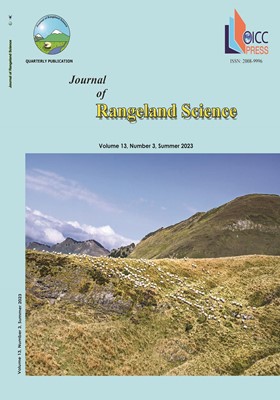Remote Sensing Monitoring of Vegetation Area and Species Diversity over Fifteen Years in Sirjan Salt Lake, Iran
محورهای موضوعی : Analysis and Evaluation
Reza Atighi
1
![]() ,
Abbas Ahmadi
2
,
Javad Varvani
3
,
Abbas Ahmadi
2
,
Javad Varvani
3
![]() ,
Hamid Toranjzar
4
,
Nourollah Abdi
5
,
Hamid Toranjzar
4
,
Nourollah Abdi
5
1 - PhD Graduted, Rangeland Science, Department of Natural Resources, Arak Branch, Islamic Azad University, Arak, Iran
2 - Assistant Prof. Department Natural Resources, Arak Branch, Islamic Azad University, Arak, Iran
3 - Associate Prof. Department Natural Resources, Arak Branch, Islamic Azad University, Arak, Iran
4 - Assistant Prof. Department Natural Resources, Arak Branch, Islamic Azad University, Arak, Iran
5 - Associate Prof. Department Natural Resources, Arak Branch, Islamic Azad University, Arak, Iran
کلید واژه: Vegetation, ASTER, NDVI index, remote sensing, Sirjan Salt,
چکیده مقاله :
This study was aimed to investigate the changes in surface and vegetation cover of the Sirjan Salt Playa (SSP) located in Kerman, Iran using Remote Sensing (RS) data. The ASTER data from 2002, 2008, and 2013 were used as the main tool. Also, using the Normalized Difference Vegetation Index (NDVI) on satellite data, the vegetation area and species diversity were determined. The research technique was correlation and comparison methods, and data analyses were made using SPSS and Edrisi software. Result showed that RS systems, in some ways, have a very good ability to study developments in desert areas. Based on the results of 15 years evaluation, the area of SSP was changed in different years and the vegetation area was changed in each period compared to the previous period, but vegetation diversity was not changed in this area. After extracting the vegetation map using NDVI index, considering the mean and standard deviation in satellite images of each period, the vegetation of the study area was divided into four classes of good, average, very poor and no vegetation. Also, the results showed that the area of good vegetation cover was 19278 ha in 2002, which increased to 22971 ha in 2008 and decreased by 20499 ha in 2013 compared to 2008. The medium vegetation class comprised 104985 ha of the land in 2002, which increased to 136128 and 108340 ha in 2008 and 2013, respectively. The kappa coefficient obtained from the comparison of the vegetation map using NDVI index and land cover map for 2002, 2008, and 2013 were 0.81, 0.83, and 0.84, respectively, which gave higher values than the SAVI vegetation index. Generally, the study suggested using other indices as NDVI and Soil-Adjusted Vegetation Index (SAVI) indices in arid lands and playa margins, with very poor vegetation cover.


